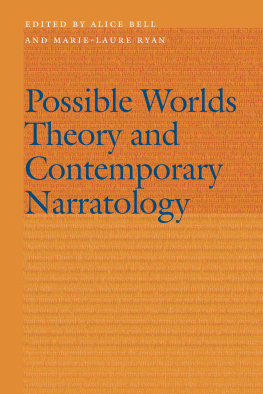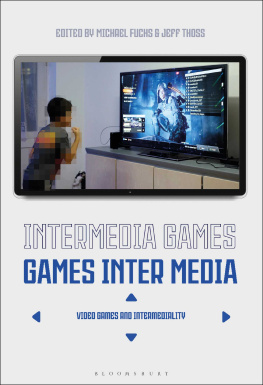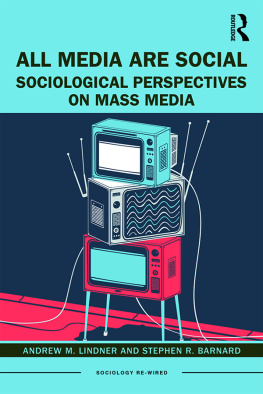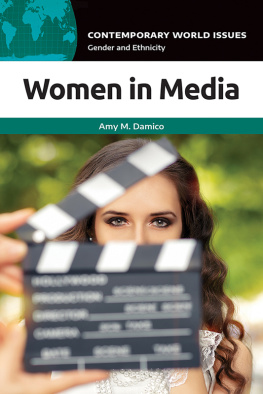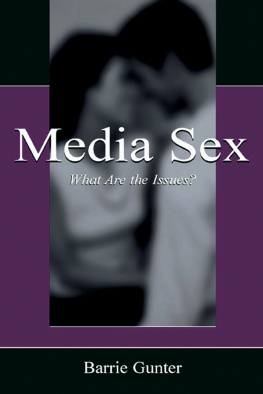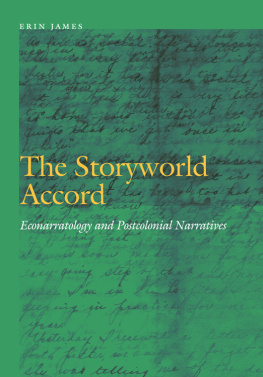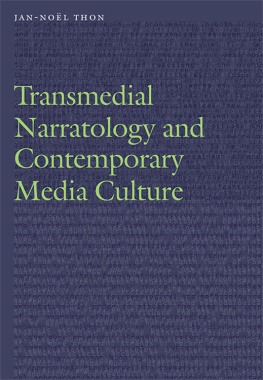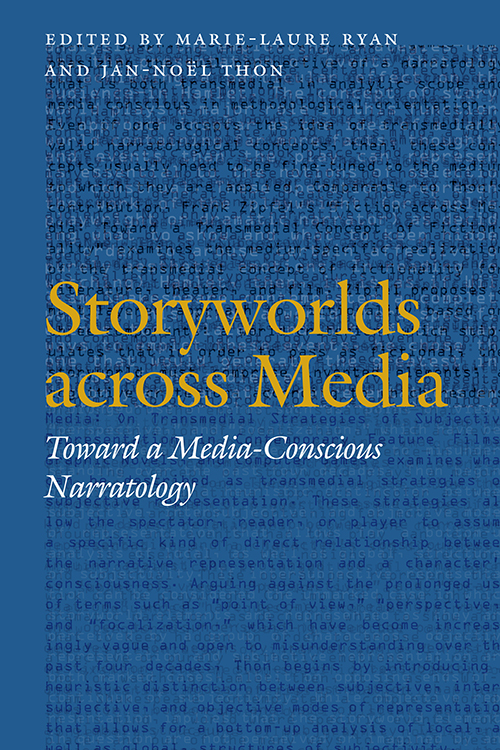
Storyworlds across Media fruitfully explores an important new concept in narrative theorythe storyworldthat is of compelling interest across disciplines, from TV writing and popular culture to digital media design and artificial intelligence.
Janet H. Murray, author of Hamlet on the Holodeck: The Future of Narrative in Cyberspace
Storyworlds across Media offers a great deal of insight into the contemporary cultural use of proliferating opportunities for innovation in storytelling.
Richard Walsh, author of Novel Arguments: Reading Innovative American Fiction
Storyworlds across Media
Frontiers of Narrative
Series Editors
Jesse E. Matz, Kenyon College
David Herman, Ohio State University
Storyworlds across Media
Toward a Media-Conscious Narratology
Edited by Marie-Laure Ryan and Jan-Nol Thon
University of Nebraska Press | Lincoln and London
2014 by the Board of Regents of the University of Nebraska.
Acknowledgments for the use of copyrighted material appear in , which constitutes an extension of the copyright page.
All rights reserved.
Publication of this volume was assisted by the Research Unit Media Convergence at the Johannes Gutenberg-University of Mainz, Germany.
Library of Congress Cataloging-in-Publication Data
Storyworlds across media: toward a media-conscious narratology / edited by Marie-Laure Ryan and Jan-Nol Thon.
p. cm.(Frontiers of narrative)
Includes bibliographical references and index.
ISBN 978-0-8032-4563-1 (pbk.: alk. paper)
ISBN 978-0-8032-5533-3 (epub)
ISBN 978-0-8032-5534-0 (mobi)
ISBN 978-0-8032-5532-6 (pdf)
1. Narration (Rhetoric) 2. Discourse analysis, Narrative. 3. Storytelling in mass media. 4. Mass media and language. I. Ryan, Marie-Laure, 1946 editor of compilation. II. Thon, Jan-Nol, editor of compilation.
P 96 .N 35 S 86 2014
302.2301'4dc23
2014003405
The publisher does not have any control over and does not assume any responsibility for author or third-party websites or their content.
Contents
Marie-Laure Ryan and Jan-Nol Thon
Marie-Laure Ryan
Patrick Colm Hogan
Jan-Nol Thon
Frank Zipfel
Werner Wolf
Wolfgang Hallet
Jesper Juul
Jared Gardner
Jeff Thoss
Marco Caracciolo
Jason Mittell
Colin B. Harvey
Lisbeth Klastrup and Susana Tosca
Maria Lindgren Leavenworth
Van Leavenworth
All the contributions collected in this volume are based on papers presented at the international conference Storyworlds across Media: MedialityMultimodalityTransmediality, which took place from June 30 to July 2, 2011, at the Johannes Gutenberg-University of Mainz, Germany. We are greatly indebted to Karl N. Renner and his colleagues from the Research Unit Media Convergence and the Transmedial Narration Work Group for inviting us to stay in Mainz and for co-organizing the conference with us.
Patrick Colm Hogans contribution to this volume, Emplotting a Storyworld in Drama: Selection, Time, and Construal in Hamlet, first appeared in Hogans How Authors Minds Make Stories (Cambridge, UK: Cambridge University Press, 2013. Print).
Jesper Juuls contribution to this volume, On Absent Carrot Sticks: The Level of Abstraction in Video Games, contains portions of his chapter A Certain Level of Abstraction in Situated Play: DiGRA 2007 Conference Proceedings, ed. Akira Baba (Tokyo: DiGRA Japan, 2007. 51015. Print).
Storyworlds across Media
Introduction
Popular culture has accustomed us to narratives that refuse to leave the stage, returning repeatedly for another round of applause and for another pot of gold. For examples, think of the many installments of the novel-based franchises of The Lord of the Rings and A Song of Ice and Fire, the movie-based franchises of Star Wars and Indiana Jones, the comics-based franchises of Batman and Spiderman, or the video gamebased franchises of Tomb Raider and Warcraft. Each of the sequels, prequels, adaptations, transpositions, or modifications that make up the body of these franchises spins a story that provides instant immersion, because the recipient is spared the cognitive effort of building a world and its inhabitants from a largely blank state. The world is already in place when the recipient takes his or her first steps in it, once again.
Following the established custom of the sequel, this book builds upon another book one of us edited in 2004, Narrative across Media. We decided to call the present book Storyworlds across Media instead of Narrative across Media II, though, in order to reflect the new directions that the study of the multiple medial incarnations of narrative has taken in the meantime. The replacement of narrative with storyworld acknowledges the emergences of the concept of world not only in narratology but also on the broader cultural scene. Nowadays we have not only multimodal representations of storyworlds that combine various types of signs and virtual online worlds that wait to be filled with stories by their player citizens but also serial storyworlds that span multiple installments and transmedial storyworlds that are deployed simultaneously across multiple media platforms, resulting in a media landscape in which creators and fans alike constantly expand, revise, and even parody them. Another difference between the present volume and the original Narrative across Media is the scope of the term across. In Narrative across Media, it referred to the comparison of the expressive power of different media with respect to the cognitive construct constitutive of narrativity, for stories and their worlds are crucially shaped by the affordances and limitations of the media in which they are realized. Now, however, across is taken in both this comparative sense and in an additional sense that refers to the expansion of transmedial storyworlds across multiple media.
Thinking of storyworlds as representations that transcend media not only expands the scope of narratology beyond its native territory of language-based narrative (native both because language was among the first media in which stories were told and because classical narratology was developed primarily with literary fiction in mind) but also provides a much-needed center of convergence and point of comparison to media studies. The explosion of new types of media in the twentieth century and their ever-increasing role in our daily life have led to a strong sense that understanding media (McLuhan) is key to understanding the dynamics of culture and society. Media are widely credited with the power to shape opinions and to participate in what has been called the social construction of reality (Berger and Luckman). But where, might we ask, does this power to construct social reality come from? For narratologists, the evident answer from medias ability to transmit stories that shape our view of the world and affect our behavior. The stories transmitted by media do not have to concern the real world to produce real behaviors. Indeed, one only needs to look at the fan cultures that develop around the sprawling fictional narratives of film and television or at the distinctive social habits of the diverse groups of players who immerse themselves in increasingly complex game worlds to find examples of a much more direct interrelation between fictional narrative representation and real social interaction.
The proliferation of the term media convergence (Jenkins) in the discourses of advertising and academia has created the sense that media are currently entering a new phase of control over culture and over our lives, capturing us in their increasingly thick web. But until we are able to tell what it is that media converge around, the term will remain a buzzwordas it was in the slogan of a 2003 technology exhibit in New Orleans: Come worship at the altar of convergence (Jenkins 6). In
Next page

